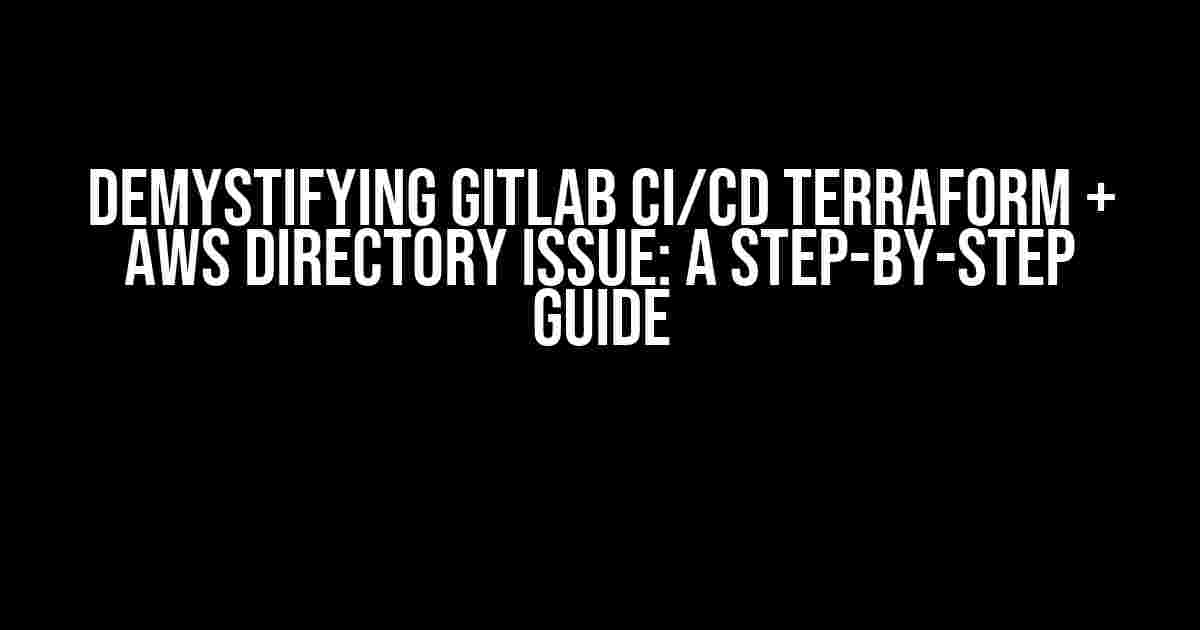Are you tired of wrestling with Gitlab CI/CD, Terraform, and AWS integration? Do you find yourself stuck with the pesky directory issue, wondering why your pipeline won’t deploy to AWS? Fear not, dear reader, for this article is designed to walk you through the solution, step by step, and get you up and running in no time!
What’s the Problem, Anyway?
In a nutshell, the directory issue arises when your Terraform configuration is stored in a subdirectory within your Gitlab repository, causing the pipeline to fail when attempting to deploy to AWS. This occurs because Gitlab CI/CD, by default, runs commands in the repository’s root directory, whereas Terraform expects to find its configuration files in the working directory.
But Don’t Panic! We’ve Got a Solution
To overcome this hurdle, we’ll take a three-pronged approach:
- Configure your Gitlab CI/CD pipeline to navigate to the correct directory
- Update your Terraform configuration to accommodate the directory structure
- Integrate AWS credentials and roles to ensure seamless deployment
Step 1: Configure Gitlab CI/CD Pipeline
image: docker:latest
stages:
- deploy
deploy:
stage: deploy
script:
- cd Terraform-Configs
- terraform init
- terraform apply -auto-approve
only:
- main
In this example, we’re using the `latest` Docker image, defining a single `deploy` stage, and specifying the script to execute. The `cd` command navigates to the `Terraform-Configs` subdirectory, where your Terraform configuration files reside. The `terraform init` and `terraform apply` commands will run accordingly.
Step 2: Update Terraform Configuration
In your `Terraform-Configs` directory, create a `main.tf` file with the following content:
provider "aws" {
region = "us-west-2"
}
terraform {
required_providers {
aws = {
source = "hashicorp/aws"
version = "~> 3.0"
}
}
}
This example defines the AWS provider and specifies the required provider version.
Terraform Backend Configuration (Optional)
If you’re using a Terraform backend to store your state files, update your `main.tf` file to include the following:
terraform {
backend "s3" {
bucket = "your-bucket-name"
key = "path/to/terraform/state"
region = "us-west-2"
}
}
Replace `your-bucket-name` and `path/to/terraform/state` with your actual bucket name and state file path.
Step 3: Integrate AWS Credentials and Roles
To authenticate with AWS, you’ll need to provide your credentials and configure the necessary roles. In your Gitlab CI/CD pipeline, add the following variables:
variables: AWS_ACCESS_KEY_ID: $AWS_ACCESS_KEY_ID AWS_SECRET_ACCESS_KEY: $AWS_SECRET_ACCESS_KEY AWS_ROLE_ARN: $AWS_ROLE_ARN
These variables will be injected into your pipeline environment. Make sure to store your credentials securely in Gitlab CI/CD variables or environment variables.
Next, update your `main.tf` file to assume the specified AWS role:
provider "aws" {
region = "us-west-2"
assume_role {
role_arn = "arn:aws:iam::123456789012:role/your-aws-role"
}
}
Replace `123456789012` and `your-aws-role` with your actual AWS account ID and role name.
Putting it All Together
With these configurations in place, your pipeline should now successfully deploy to AWS. Here’s a summary of the steps:
- Create a `Terraform-Configs` subdirectory in your Gitlab repository
- Configure your Gitlab CI/CD pipeline to navigate to the `Terraform-Configs` directory
- Update your Terraform configuration to accommodate the directory structure and AWS provider
- Integrate AWS credentials and roles in your pipeline
Troubleshooting Tips
If you encounter issues during deployment, refer to the following common pitfalls:
- Verify that your Terraform configuration files are stored in the correct directory
- Check that your AWS credentials and role are correctly configured
- Ensure that your pipeline has the necessary permissions to deploy to AWS
- Review your Terraform state files for any inconsistencies or errors
Conclusion
By following this step-by-step guide, you should now be able to overcome the Gitlab CI/CD Terraform + AWS directory issue and successfully deploy your infrastructure to AWS. Remember to stay calm, be patient, and troubleshoot methodically. Happy coding!
| Keyword | Description |
|---|---|
| Gitlab CI/CD | Continuous Integration and Continuous Deployment tool |
| Terraform | Infrastructure as Code tool for deploying and managing infrastructure |
| AWS | Amazon Web Services cloud platform |
| Directory Issue | Common problem where Terraform configuration files are not found in the correct directory |
This article provides a comprehensive solution to the Gitlab CI/CD Terraform + AWS directory issue, walking you through the necessary configurations and troubleshooting tips. By following this guide, you’ll be able to overcome this hurdle and successfully deploy your infrastructure to AWS.
Frequently Asked Question
Get the scoop on Gitlab CI/CD Terraform + AWS directory issue!
Q1: Why does my GitLab CI/CD pipeline fail when trying to deploy Terraform on AWS?
This might be due to incorrect directory permissions or incorrect configuration of the Terraform backend. Make sure to check the pipeline logs for more details and verify that the directory has the correct permissions and configuration.
Q2: How do I troubleshoot Terraform initialization issues in my GitLab CI/CD pipeline?
To troubleshoot Terraform initialization issues, you can try running the pipeline with the `TF_LOG` environment variable set to `DEBUG`. This will provide more detailed logs to help you identify the issue. Additionally, you can also try initializing Terraform manually in the pipeline using the `terraform init` command.
Q3: Why does my GitLab CI/CD pipeline fail to deploy Terraform on AWS with an “Invalid bucket name” error?
This error usually occurs when the S3 bucket name is not correctly configured or does not exist. Verify that the bucket name is correct and that the IAM role used by the pipeline has the necessary permissions to access the bucket.
Q4: How do I handle sensitive data in my Terraform configuration file when using GitLab CI/CD with AWS?
To handle sensitive data, you can use GitLab CI/CD variables or environment variables to store sensitive information such as AWS access keys or secret keys. You can also use a secrets manager like HashiCorp’s Vault or AWS Secrets Manager to securely store and retrieve sensitive data.
Q5: Can I use a different Terraform backend instead of S3 when deploying to AWS using GitLab CI/CD?
Yes, you can use different Terraform backends such as Terraform Cloud, Azure Blob Storage, or Google Cloud Storage. However, you will need to configure the backend accordingly and ensure that the necessary permissions and credentials are in place.


